Installing Windows 7 Wont Continue Without Drivers
Z7_3054ICK0KGTE30AQO5O3KA30N0
hp-concentra-wrapper-portlet
![]() Actions
Actions
HP Notebook PCs - Installing Windows 10
This document is for HP notebook computers with Windows 8.1 or Windows 7.
Install Windows 10 on a computer that came with Windows 8.1 or Windows 7 using the instructions in this document.
Important information about installing Windows 10
Please read the following important information before beginning:
-
Make sure to back up your important files.
caution:
You should always back up all important data (such as personal files, photos, videos, documents, applications, software) before beginning to avoid any possibility of losing your data. See Backing Up Your Files (Windows 10, 8) for more information.
-
HP provides installation instructions, compatible software, and updated drivers for most computers sold after August 2013.
-
If you purchased your computer prior to August 2013, HP has not tested or developed drivers for your computer model. Some features might not work, or the installation might not be successful.
-
Make sure you have installed the latest version of drivers for your Windows 7 or Windows 8.1 product using HP Support Assistant, or download them from HP Customer Support.
-
Update your antivirus software and the antivirus definitions before installing Windows 10. Set the antivirus application to update automatically. Go to the antivirus software manufacturer website for more information.
-
If your computer hard drive is encrypted using HP ProtectTools or other security applications, you must decrypt the hard drive before starting the installation.
-
If you seek support assistance from HP after the installation, HP technical support might request that the original Windows operating system be restored to verify product functionality. If your computer is sent to service for repairs after installing Windows 10, your computer could be re-imaged with the original Windows operating system and Windows 10 removed. After repairs are made, you can reinstall Windows 10. Be sure to remember your Microsoft account login and password. To reset your password, see HP Guided Solution - Unable to Log in to Windows.
-
With Windows 10 installed you automatically receive updates and security fixes from Microsoft. You cannot opt out of this service.
-
If you want to restore the original operating system, it is best to obtain HP recovery media before you install Windows 10. To learn how to create recovery media, see Obtaining HP Recovery Discs or an HP USB Recovery Drive.
-
Not all Windows 10 features are available on all computers. Your particular experience with Windows 10 is determined by the capabilities of your computer.
-
Apps are sold separately.
-
Software designed for Windows 8.1, or earlier operating systems, might not work after installing Windows 10.
-
If you installed third-party software after purchasing your HP computer, you should verify that it is supported in Windows 10 by contacting the software vendor.
-
Some graphics hardware does not support the new WDDM 2.0 driver design. While the graphics should work on Windows 10, the computer does not benefit from the performance improvements available to graphics that support WDDM 2.0.
-
You might not be able to view DVD movies after installing Windows 10. If you currently use a DVD codec to play DVD movies, such as the encoder that comes with Windows 7 Professional, this encoder might not be available in Windows 10. To continue to play DVDs after you install Windows 10, install a new media player app from the Windows Store or another trusted source.
-
Windows Media Center does not work after installing Windows 10. It is removed during the installation and cannot be installed afterwards.
-
For computers with available storage of 128 GB or less, the installation might require you to provide a USB hard drive (32 GB or larger). HP does not recommend using an SD card.
SD card slots might not work after installing Windows 10. For this reason it is recommended to use only USB or microUSB external storage, not an SD card, as Windows 10 installation media.
-
Microsoft includes a free voice recorder app in Windows 10 to record your interviews, classes, business meetings, and voice notes. This application might not work as expected on all machines. If recording functionality is missing on your device, check Windows Update for the latest driver.
-
Face authentication requires specific hardware such as an infrared (IR) camera. If the computer does not have this hardware installed, the option to set up face authentication in the Settings app is not available.
-
Fingerprint authentication can be set up in the Settings app for computers that have swipe or scan fingerprint readers. If the option to set up fingerprint reader in the Settings app is not available, you might need to upgrade the security software on your computer. In Windows 10, download and install the latest HP SimplePass or Digital Persona software. If you are using security software from another manufacturer, check with the manufacturer of that software.
-
The Cortana personal assistant feature uses specific hardware such as a microphone, speakers, GPS and an Internet connection. The microphone in your computer might need to be configured to work with Cortana and results vary based on the specific microphone. Cortana might not be available in all countries/regions.
-
In Windows 10, Wireless Display (Miracast) might not connect to an external display or might lose connection. Updated video and wireless drivers are required to enable the functionality. Check Windows Update for the latest drivers and install them when they are available.
-
Microsoft Refresh and Reset might not correctly restore drivers and customizations specific to your HP system. You should only use HP Recovery Manager to restore the factory image, or Go Back to return to Windows 8.1. After Go Back is expired, use HP Recovery Manager (if available) and re-install Windows 10 if a recovery is needed.
-
Multi-finger Precision Touchpad, a new Windows 10 feature, provides high-precision pointer input and new gesture functionality. Your computer does not support the hardware requirement for Multi-finger Precision Touchpad. This feature requires specific hardware to function in Windows 10. In Windows 10 your touchpad will still work properly.
-
Computers configured with Intel Broadwell (Intel Core i3-5xxx, Core i5-5xxx, Core i7-5xxx; Pentium 38xx, Celeron 37xx/32xx) or Haswell (Intel Core i3-4xxx, i5-4xxx, i7-4xxx; Pentium 35xx, Celeron 29xx) processors and 32-bit versions of Windows 8.1 are not capable of installing to Windows 10 32-bit using the Windows Upgrade tool. To install Windows 10 64-bit, purchase Windows 10 64-bit from Microsoft and perform a clean install of Windows 10 64-bit from the Microsoft download site. In some cases HP might not provide compatible software and updated drivers for your model.
-
Some computers with IDT audio controllers might not have full functionality after installing Windows 10. The Windows 10 driver provides audio for the computer, but some features do not work.
-
On 2-in-1, x360 and convertible notebooks, the continuum feature in Windows 10 might not automatically detect when the computer is in tablet or desktop mode. You can manually switch between modes in the action center.
-
Some computers do not support DirectX 12. You might not be able to use some new features in the XBOX app or use applications that require DirectX 12.
System requirements
Microsoft requires that your computer hardware meet the following system requirements before you can install Windows 10.
| Requirement | Minimum | Recommended |
| Processor | 1 gigahertz (GHz) IA-32 or x64 architecture Support for PAE, NX and SSE2 | x64 architecture Second Level Address Translation (SLAT) support for Hyper-V |
| Memory (RAM) | IA-32: 1 GB x64 edition: 2 GB | 4 GB |
| Graphics Card | Microsoft DirectX 9 graphics device with WDDM driver | DirectX 10 |
| Display screen | 800 x 600 pixels | 1024 x 768 pixels (to access Windows Store) |
| Input device | Keyboard and mouse | Multi-touch display |
| Hard disk space | 16 GB for IA-32 20 GB for x64 | Same as minimum |
| Other | Internet connection | |
Steps to take before installing
Before installing Windows 10, update your software, drivers, and BIOS, create recovery discs for your current operating system, and back up your files. You might also need to decrypt the hard drive.
Step 1: Install the latest software and driver updates from HP Support Assistant
Step 2: Update the BIOS
Download and install the latest version of the BIOS for your computer. See Updating the BIOS for more information.
Step 3: Create recovery discs and back up your important files
Create recovery discs and use File History to back up your data.
-
If you have not already done so, create a set of Windows 8.1 or Windows 7 system recovery discs or save a recovery image to a USB storage device. If a problem occurs during the installation process, you can use HP System Recovery to return your computer back to its original software configuration. To create your recovery solution, see Obtaining HP Recovery Discs or an HP USB Recovery Drive.
-
You can use File History to back up your files and transfer them to Windows 10. To create a backup of your files, see Backing Up Your Files (Windows 10, 8).
Step 4: Decrypt the hard drive (if applicable)
The Windows 10 installation does not complete if the hard drive is encrypted. If you have encrypted the hard drive, you must decrypt the hard drive before beginning the installation.
Installing from a USB drive or ISO file using Media Creation Tool
You can use Media Creation Tool to create Windows installation media, and then use the media to install Windows 10.
Step 1: Create the Windows installation media
Download Media Creation Tool, and then create the installation media.
note:You can run Media Creation Tool and create the Windows installation media on any computer.
-
Click Download tool now.
-
Click Open, Save, or Run in any windows that display to download the tool to your computer.
-
Double-click the MediaCreationTool.exe file in the browser downloads bar or in the Downloads folder on the computer to launch the installation.
-
Accept the license terms.
Figure : Accepting the license terms

-
Select Create installation media (USB flash drive, DVD, or ISO file) for another PC, and then click Next.
Figure : Selecting Create installation media (USB flash drive, DVD, or ISO file) for another PC
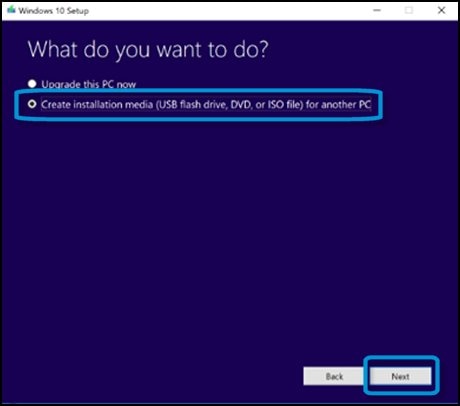
-
Select the language, edition, and architecture (64-bit or 32-bit) for the Windows 10 installation, and then click Next.
Figure : Selecting language, edition, and architecture
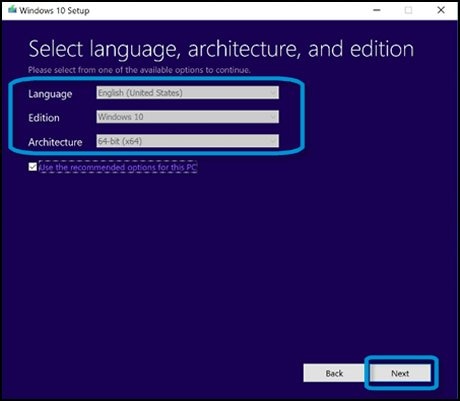
-
Insert a blank USB drive (16 GB or larger is recommended), select USB flash drive, and then click Next.
note:
If you prefer, you can insert a blank DVD, select ISO file, and then click Next. Installation from ISO media is for advanced users.
Figure : Choosing USB flash drive

-
Select the USB flash drive, and then click Next.
Figure : Clicking Next
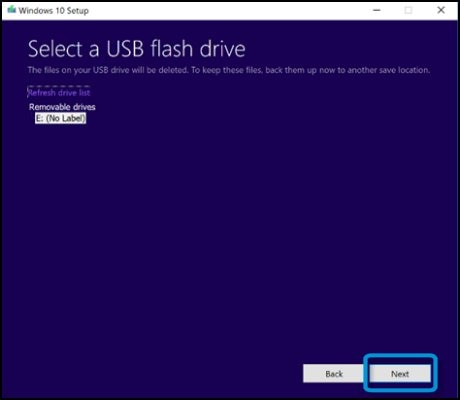
-
After the Media Creation Tool finishes creating the installation USB drive, click Finish.
Figure : Clicking Finish
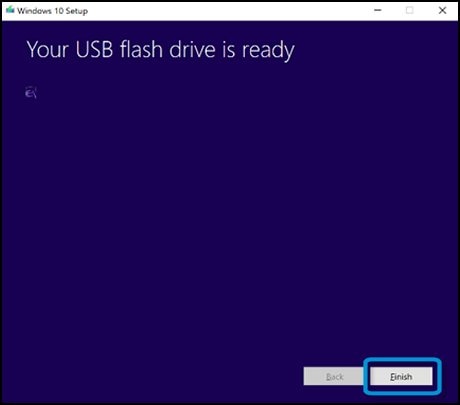
Proceed to the next step to install Windows 10 on your computer using the installation media.
Step 2: Install Windows 10 on your computer
Windows 10 Setup allows you to do a clean installation of Windows 10 (erases all data) or to keep your personal files and apps (HP still recommends backing up all data in the event of any data loss).
note:If you are prompted to supply the Windows 10 product key, type the product key, and then click Next.
note:If your computer has less than 128 GB of free hard drive space, you are prompted to connect a USB hard drive to continue with the installation. Use a blank USB hard drive 32 GB or larger. When the installation is complete, Windows 10 Upgrade copies the windows.old file to the USB hard drive. Keep this file on the USB hard drive. The file is required if you decide to Go Back to the previous operating system.
-
Insert the Windows installation USB drive into the computer.
note:
If you created an installation DVD using an ISO file, insert the DVD, and then install Windows 10.
-
Open the USB drive in File Explorer, and then double-click the setup file.
If a User Account Control window displays, click Yes.
-
When the Get important updates window opens, select Download and install updates (recommended), and then click Next.
Figure : Selecting Download and install updates (recommended)

-
Accept the license terms.
Figure : Accepting the license terms
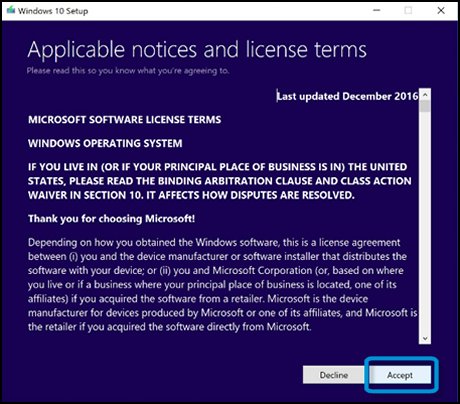
-
In the Choose what to keep window, select what you want to keep, and then click Next.
-
Keep personal files and apps: Keeps all your personal files, settings, and apps.
-
Keep personal files only: Keeps your personal files, but no settings or apps.
-
Nothing: Keeps nothing and erases all data.
Figure : Choose what to keep window with Keep personal files and apps selected
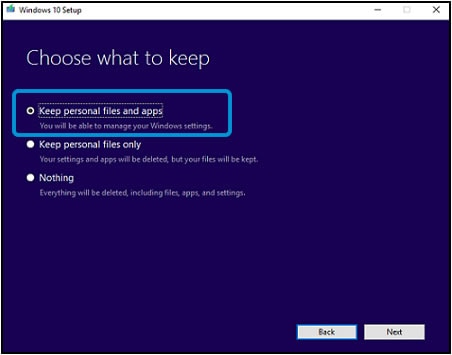
-
-
In the Ready to install window, click Install.
The installation begins.
During the installation process, your computer restarts several times. Do not turn off your computer or interrupt the installation process. If the sign-in window displays, sign in to your account.
-
If you chose Keep personal files and apps, the desktop opens when the installation completes.
-
If you chose Keep personal files only, the desktop opens when the installation completes.
-
If you chose Keep nothing, continue to the next step after the installation completes to set up Windows 10.
Figure : Clicking Install

-
Step 3: Complete setup and sign in to Windows 10 (clean installation only)
If you chose the clean install and kept nothing, navigate the setup experience with the help of Cortana. If you chose to keep your personal files and apps, you do not need to set up Windows 10 again.
-
When the Cortana introductory screen displays, you can choose to use Cortana voice recognition (if your computer has a working microphone) or your keyboard and mouse to complete the setup.
If you do not want to use Cortana voice recognition, click the speaker icon in the lower right corner, and then mute the volume.
Figure : Cortana introductory screen
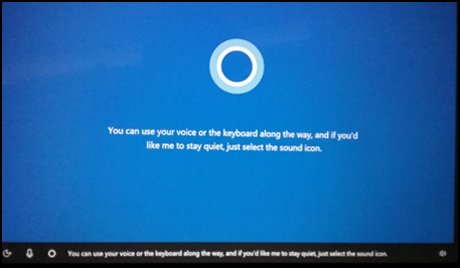
-
When the Let's start with region. Is this right? screen displays, select your region, and then click Yes.
-
When the Is this the right keyboard layout? screen displays, select your keyboard layout, and then click Yes.
-
When the Want to add a second keyboard layout? screen displays, select Add layout and follow the on-screen instructions to add another keyboard layout, or select Skip to continue without a second keyboard layout.
-
When the Let's connect you to a network screen displays, select the network you want to connect to, and then click Connect and type your network user name and password, or click Skip for now to continue without connecting to a network.
-
On the Sign in with Microsoft screen, type your email, phone, or Skype name in the text field, or create an account, and then click Next.
Figure : Signing in with your Microsoft account

-
Type your password in the text field, and then click Next.
If you see a Call us overprotective screen requesting an additional method of account verification, select the way you want to verify the account, and then click Next.
Figure : Typing your Microsoft account password

-
Read the options displayed on each screen, select the options you want, and then follow the on-screen instructions to continue.
-
When the Choose privacy settings for your device screen displays, select the options you want, and then click Accept.
The installation completes, and the desktop opens.
Figure : Choosing privacy settings for your device
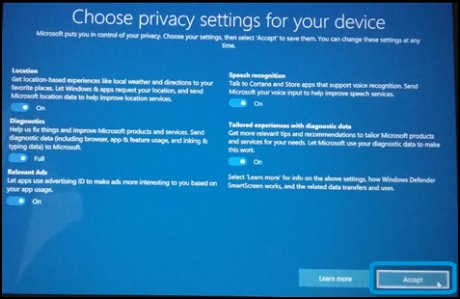
Windows activation
To verify that you have a genuine copy of Windows 10 that has not been used on more devices than the license agreement calls for, your Windows 10 needs to be activated. Depending on where you acquired your copy of Windows 10, activation occurs using either a digital entitlement or a 25-character product key.
Windows Hello
To unlock your computer with your fingerprint or with your face, without a password, you can use Windows Hello. It is a much more personal and very secure way to unlock your Windows 10 device. If your computer has the hardware required for Windows Hello, you are prompted to set up Windows Hello during Windows 10 setup.
If Windows Hello does not activate automatically and you want to use the facial recognition or fingerprint reader, follow these instructions after Windows 10 is activated.
-
Click Start
 , and then click Settings
, and then click Settings  .
. -
Click Accounts.
-
Select Sign-in options.
-
Under Windows Hello, options for face, fingerprint, or iris display if your computer has the fingerprint reader or camera to support the feature.
After setting up Windows Hello, you can sign into your computer with the swipe of a finger or a quick glance.
Steps to take after installing Windows 10
After installing Windows 10, update your drivers, software, and apps.
-
Connect to the Internet if your computer is not already connected.
-
Install the latest updates from Windows Update.
-
Sign in to the Windows Store and update any Windows apps.
-
Install HP Support Assistant. HP Support Assistant scans your computer and automatically detects and installs the latest software drivers available from HP. Go to HP Support Assistant to download and install HP Support Assistant for Windows 10.
-
Install updated video drivers. For the best viewing experience, download and install the latest graphics drivers for your computer. Go to HP Customer Support, select Software and Drivers, and then enter your computer model number. Download and install the Windows 10 video drivers for your computer.
-
Install updated wireless network drivers and wireless button software. The wireless button on your computer should sync with Windows Airplane Mode when the required software is installed. Go to support.hp.com and install the latest BIOS for your computer if you have not already done so. Then install the latest wireless and Bluetooth drivers. Finally, install the HP Wireless Button softpaq.
-
Install updated audio drivers. Audio from your speakers and headphones should work properly after Windows 10 is installed, but to get the most from your audio system, install the latest HP audio drivers.
-
Install updated touchpad drivers. The touchpad should work properly after Windows 10 is installed, but installing the Windows 10 touchpad driver allows you to use edge swipe features from the touchpad to switch between open applications and other useful functions.
-
Learn how to use Windows 10. Read the HP support document Understanding and Using Windows 10 Features to learn new Windows 10 features, the apps that come with Windows 10, and much more.
-
Delete Windows installation files to regain storage space.
The "Go Back" feature, which allows you to reinstall a previous version of Windows, is available for 10 days after installing Windows 10. The Windows installation files occupy a large amount of hard drive storage space during that time. The files are deleted automatically after 10 days. However, if you want to regain the storage space before 10 days have passed, you can manually delete the files.
note:
After deleting the files, the Go Back feature is no longer available for restoring a previous version of Windows.
-
Using the search box on the taskbar, search for and open Disk Cleanup.
Figure : Opening Disk Cleanup

-
Select the hard drive where the Windows installation files are stored (usually C:) and then click OK.
The Disk Cleanup scans the drive for files that can be deleted.
Figure : Selecting the drive

-
When the Disk Cleanup wizard opens, click Clean up system files.
Figure : Clicking Clean up system files

-
Select the hard drive where the Windows installation files are stored (usually C:).
Disk Cleanup scans the drive for system files that can be deleted.
-
Select Previous Windows installation(s) and Temporary Windows installation files, and then click OK to start the cleanup.
When the disk cleanup is complete, more free space is available on the computer hard drive.
-
Go back to the previous version of Windows
Go Back is a feature that returns your computer to the operating system that was installed before you installed Windows 10.
note:The Go Back option is only available for 10 days after installing Windows 10. If you perform a disk cleanup, refresh, or reset in Windows 10, you do not have the option to go back. If you have deleted the windows.old file from your computer, you do not have the option to go back. If your installation required an external USB drive you must use the same drive to go back.
-
Prepare to go back.
-
Although your personal files should not be affected by going back, it is recommended that you back up all important data (personal files, photos, videos, documents, applications, software, etc.) before going back, to avoid any possibility of losing your data. See Backing Up Your Files (Windows 10, 8) for more information.
-
If you used a different password with the previous Windows version on your computer, you might need your old password.
-
Keep your PC powered on and plugged in to a power source for the duration of the go back process.
-
After going back, you need to reinstall some apps and programs, and any settings changes are lost.
-
-
Using the search box on the taskbar, search for go back, and then click Go back to an earlier build.
The Recovery window opens in Settings.
Figure : Clicking Go back to an earlier build
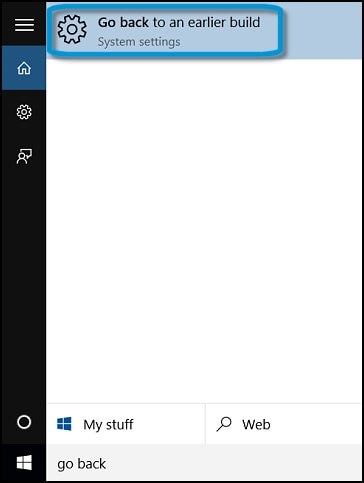
-
In the Go back to an earlier build section, click Get started.
Figure : Clicking Get started
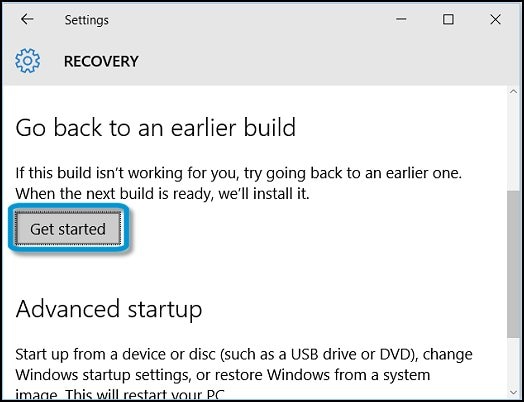
-
On the Why are you going back? window, select an answer, type more details into the Tell us more field (optional), and then click Next.
Figure : Why are you going back? window
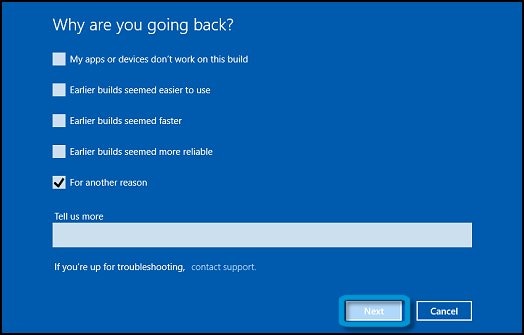
-
Read the What you need to know window, and then click Next.
Figure : What you need to know window

-
Windows reminds you that you need your old password, if applicable. Click Next.
Figure : Don't get locked out window
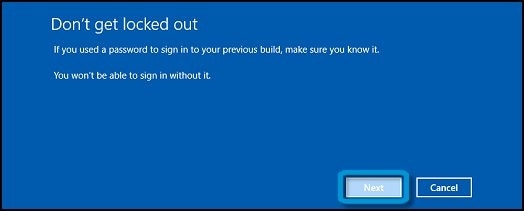
-
Click Go back to an earlier build.
-
Wait while your system is restored to the previous version of Windows. Do not turn off or unplug the computer.
When Go Back is complete, sign in with the user account and password from your previous version of Windows.
Source: https://support.hp.com/id-en/document/c04730900
0 Response to "Installing Windows 7 Wont Continue Without Drivers"
Post a Comment